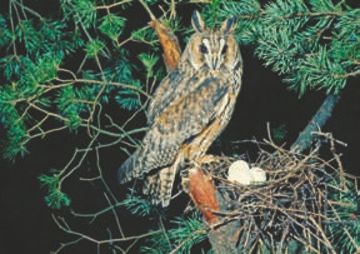
Long-eared Owl © Peter Smith
This survey confirmed that the Mersey valley is the only part of the county where this elusive species can regularly be found in the breeding season. They favour dense scrub and young woodland for nesting, with adjacent areas of rough grassland in which to feed. ‘Cheshire is blessed with few suitable habitats and most owls occur far away from natural sites. Instead, Long-eared Owls are found on lands largely created inadvertently by man, by-products of various industries and derelict areas. Many of these habitats, some of which have become rich in small mammals, are often temporary, awaiting further development - landfill, housing, mineral extraction, business parks and so on, to name a few.’ (Lees 1994).
Long-eared Owls hunt almost exclusively at night, with their main method being to quarter an area, flying silently to and fro at a height of about 1 m, and dropping onto their prey. British studies have found small mammals to make up most of the diet, headed by Field Vole, typically half of the items consumed, followed by Wood Mouse, Bank Vole, Common Shrew, Brown Rat, Pygmy Shrew and Water Vole. Odd birds take Rabbit, Grey Squirrel, House Mouse and Pipistrelle Bat. They also take roosting birds, deliberately beating the branches of a bush to disturb their prey; owls often work in pairs using this technique (Scott 1997). House Sparrows are reported to be the bird by far the most commonly taken, but the list extends to at least fifty species.
It is quite difficult to prove the presence of Long-eared Owls and the species has probably been under-recorded. Birds are strictly nocturnal, and their soft, mournful call does not carry far and is mostly given early in the year, typically during February. However, they can be faithful to an area so, once found, it is straightforward to check on them each year. By far the easiest way of finding them, and of proving breeding, is to hear the creaking calls of the young, every few minutes all night long.
Wherever they occur, Long-eared Owls are widespread but thinly distributed, as shown by the figures for occupation of adjacent counties in breeding atlases. They were found in 9 out of 670 tetrads (1.3%) in this survey, 20 out of 870 tetrads (2.3%) in Shropshire (1985-1990), 38 out of 931 (4.1%) in Lancashire and North Merseyside (1997-2000) and 12 out of 1844 (0.6%) in Cumbria (1997-2001).
All texts on the species emphasise its vulnerability to competition, even extending to direct attack, by Tawny Owls, and Long-eared Owls flourish in Ireland and the Isle of Man where Tawnies are absent. Now that Tawny Owls have declined in Cheshire, there is potential scope for expansion of Long-eared Owls, if the habitat is right. A century ago, in Coward’s day (1900), this was the commonest owl ‘in the wooded parts of the Hill Country’.
Lees (1994) noted substantial year-to-year fluctuations in population and estimated a Cheshire total of 11 to 20 pairs; he wrote that ‘Long-eared Owls breed in six of Cheshire's 37 10km squares and have, in the past, occurred in another five or six at which breeding remains unconfirmed’. This is higher than the distribution show by this Atlas but, optimistically allowing for an element of under-recording and some undetected pairs, the present total might just be into double figures.Sponsored by Steve Binney

